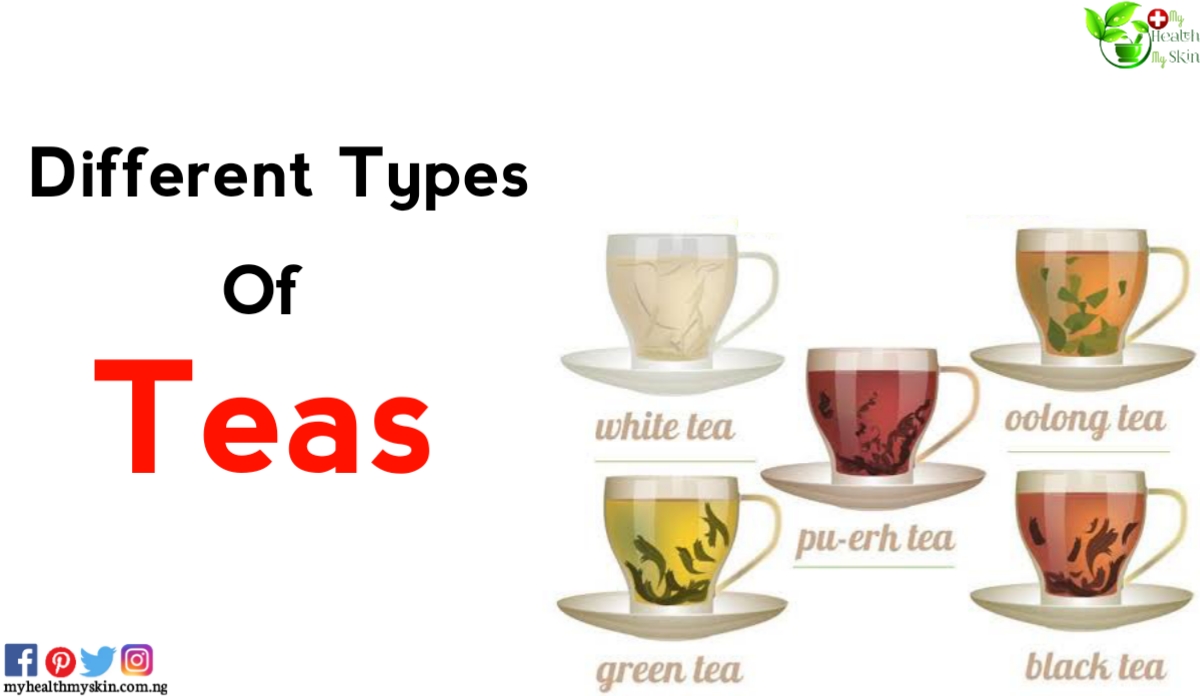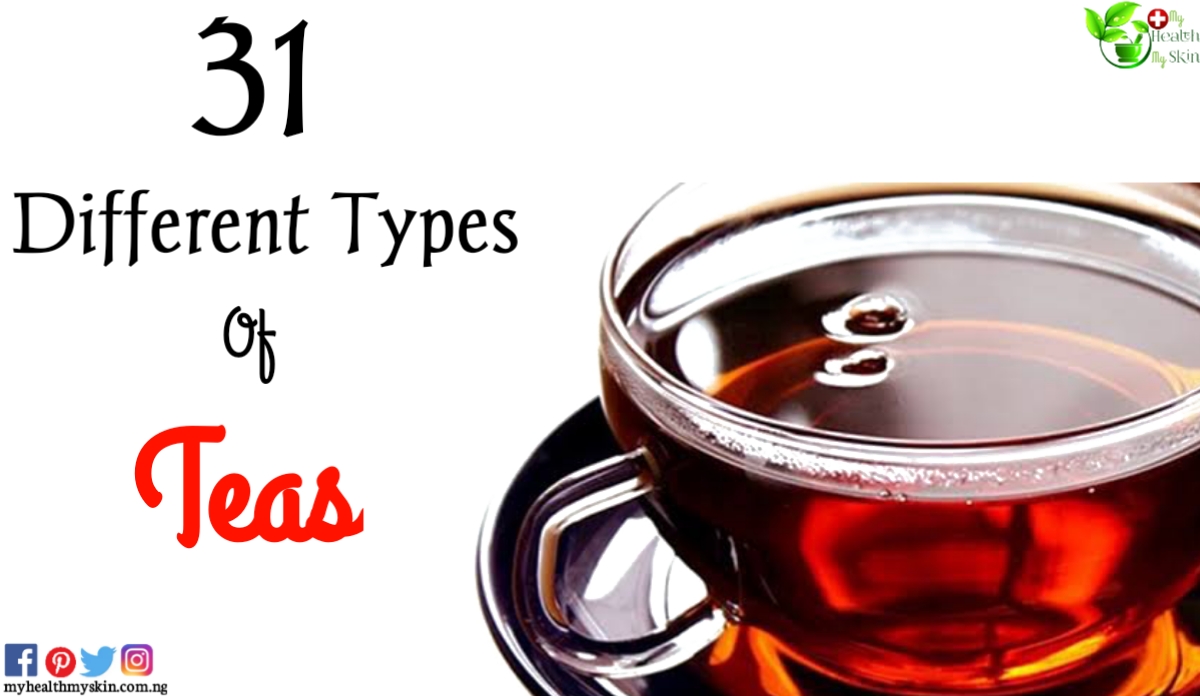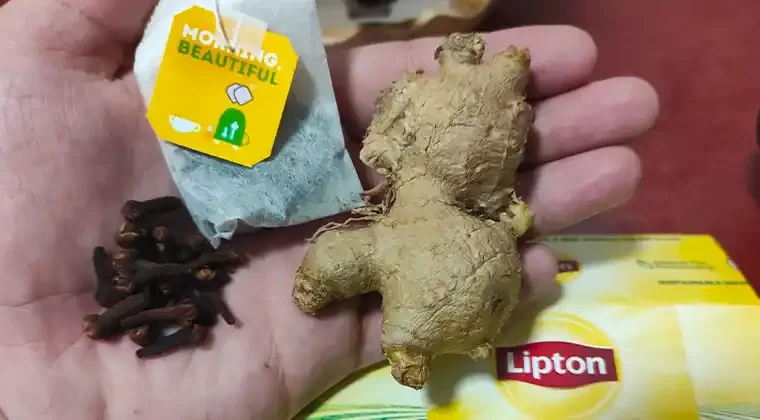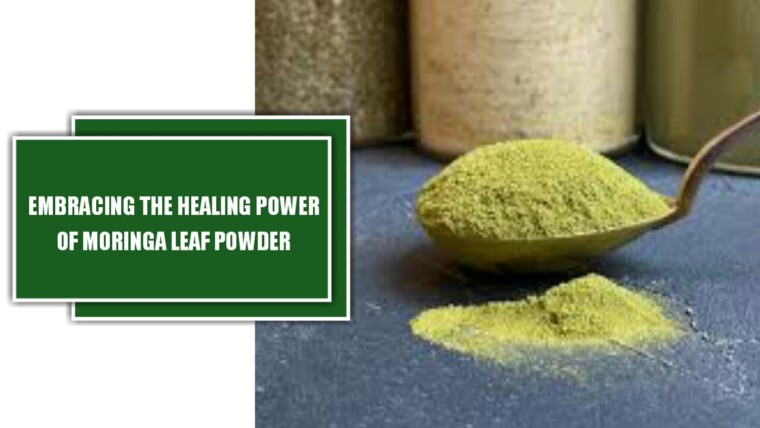There are many different types of tea in our lives, according to the different main points of the processing technology: black tea, green tea, yellow tea, black tea, white tea, green tea, etc.
Tea, as a healthy health care products, can quietly change the health status, discharge the toxins in the body, so that the body and mind make it easier.
However, not every tea is suitable for everyone. Before drinking tea, it is very necessary to understand the effects of various tea corresponding to the various tea.
This article takes a look at 31 types of tea, their potentials, and a summary of research into their health benefits (where applicable).
Different Types of Tea

Firstly, it’s very important to know that true “tea” all comes from the same plant; Camellia sinensis. And there are also various popular types of herbal teas too.
The Five True eas;
- White tea
- Black tea
- Green tea
- Oolong tea
- Pu-erh tea
Secondly, Teas are classified depending on how the plant’s tea leaves are prepared and processed. Here’s 31 types of tea:
31. Oolong Tea
Oolong is another of the “true” teas and it comes from the leaves of the camellia sinensis plant.
But just what is it and how does it compare to green and black teas?
Firstly, oolong is a partially oxidized tea – it undergoes part of the same process as black teas.
Depending on the degree of leaf oxidation, it may taste closer to a green or black tea.
Oolong has a mixture of the potential benefits that green and black teas provide, and it contains a range of polyphenols found in both.
In terms of human research, a small study found that oolong tea might be effective for helping control blood glucose levels.
Additionally, the tea contains a wide range of polyphenols that may potentially help to reduce levels of oxidative stress.
30. Green Tea
Green tea is one of the five true teas. It is a new leaf or bud in tea trees, and has not been fermented, and it is directly produced by typical processes such as drying. Finding tea out of teas, more reserved fresh tea green nature.
There are many types of green teas: The People’s Green Tea, Tazo Green Tea, Teavana Jade Citrus Mint, The Republic of Tea Detox Green Supergreen Tea, Uncle Lee’s Organic Green Tea, Lipton Decaffeinated Green Tea Bags, etc.
Green tea has special effects on anti-aging, anti-cancer, anti-cancer, bactericidal, anti-inflammatory, etc., and has not been fermented.
Drinking green tea always can prevent cancer, lower blood fat and lose weight. Smokers can alleviate nicotine damage. Hypertensive patients, excessive eating greasy food, small and unfavorable people can drink green tea. Note that patients with neurasthesia symptom is not suitable for drinking green tea.
29. Black Tea
Black tea is a major raw material with a bud leaves of a tea tree, a typical processed by withered (cut), fermentation, drying and other typical processes. Because of its dry tea color and brewed tea soup, it is red tea.
The main varieties of black tea have the red, Sichuan Red, Assam Black Tea, British Red, Darjeeling Black Tea, Blush, Purple, Spring City Red, Su Hong, etc., of which Tuen Mun black tea is the most famous, and the national origin is protected, and the rhenever and the deterioration effect is remarkable.
Black tea helps digestive, warm stomach, and refresh the role of fatigue. It also resists aging and certain anti-cancer effects. It is worth nothing that women during menstruation, during pregnancy, menopausal women, and those who are easy to get angry with the stone should not drink black tea.
28. Peppermint Tea
The dried leaves of the peppermint plant (mentha x piperita) make a bold, refreshing, and very minty tea.
It has a strong flavor and smell, so if you’re looking for a mild flavor, you won’t find it here, but peppermint is an enjoyable tea to drink.
There have been various small studies on this herbal tea, but there is no real significant research that shows a health benefit to the drink.
On the contrary, observational research has linked frequent consumption of mint tea to an increased risk of gastroesophageal reflux disease (GERD) in people with the condition.
27. Pu-erh Tea
It is also a fermented drink, and similar to red wine or kombucha, pu-erh contains lots of live bacteria.
This is due to the production process; the processing of the leaves allows for microbial fermentation. As a result, the tea continues to age and change even after drying the leaves.
Pu-erh is a Chinese drink and it has the local name of ‘heicha’. Generally speaking, the taste is more bitter than standard tea, although it does become milder over time.
Traditionally, green pu-erh tea is the preferred choice and it has been around for centuries. However, making pu-erh from black tea has also ecome popular over the last few decades. Pu-erh has an equivalent caffeine content to whatever type of tea it is made from.
Randomized controlled trials demonstrate that pu-erh tea might potentially improve health markers in patients with metabolic syndrome.
26. Pau d’arco Tea
Pau d’arco bark (otherwise known as taheebo) is a herb that comes from the pau d’arco tree.
These trees grow in the Amazon rainforest and the inner bark (taheebo) contains a variety of phytonutrients.
The tea is also rather tasty, and it has an interesting fruity/herby flavor that is hard to describe.
That said, be careful of unsubstantiated health claims, especially those relating to cancer. For instance, a quick search for pau d’arco brings up all kind of results suggesting it’s an alternative “cancer-fighting” therapy.
However, this borders on pseudoscience since there are no controlled studies in humans that provide evidence for this.
On this note, the Memorial Sloan Kettering Cancer Center notes that while laboratory (cell) studies show antibacterial and anticancer effects, “these effects have not been shown in humans” .
25. Raspberry Leaf Tea
Raspberry leaves (Rubus idaeus) grow on the raspberry plant and they have a long history of use.
These uses include various traditional herbal remedies and also as a refreshing tea.
Despite the name, the tea doesn’t really taste like raspberries, and the flavor is similar to other green/grassy teas. It is a popular drink and since it’s non-caffeinated, it’s a good match for those looking for a caffeine-free option.
Raspberry leaf has traditionally been a folk remedy for pregnancy, and it is believed to shorten the labor period.
However, there is limited research in this area for humans. Only one randomized trial has been undertaken, but this trial didn’t show any significant differences other than a very slight (9-minute) shortening of the second stage of labor.
24. Rooibos Tea
Rooibos (pronounced “roy-boss”) is one of the most popular types of tea.
Otherwise known as ‘red bush’, the tea originates in South Africa where it has been popular for centuries.
People generally consume the drink in a similar way to black tea; some prefer it “black” (red) and others add some milk and/or sugar.
Rooibos has an interesting taste, and it is equal measures of fruity, spicy, and nutty. For those sensitive to caffeine, rooibos has the benefit of being caffeine-free.
The tea contains a variety of phenolic compounds including flavanones and flavones.
23. Rose Tea
The rose (rosa) is a flower that grows all around the world. Rose tea comes from the dried petals of the flower.
These dried leaves can either make a pure tea or can combine with other herbs to make a rose-flavored drink.
In terms of taste, rose tastes light, sweet, and slightly tart. The mildly sour notes come from the rose petal’s citric and malic acid content.
Also, the dried petals contain various anthocyanins, the same class of polyphenol present in different types of berries.
22. Rosemary Tea
Rosemary isn’t only a herb for culinary purposes, but it is also a popular variety of herbal tea.
Making rosemary tea simply involves steeping approximately a teaspoon of rosemary leaves (fresh or dried) in hot water.
Once the tea has been brewing for several minutes, the color of the water will be light yellow and offer a mild-tasting tea. For a stronger brew, steeping the leaves for 5-10 minutes will provide a more flavorful rosemary tea.
Rosemary tea offers an earthy and mildly minty flavor, and it’s a tasty and relaxing herbal tea.
The drink also provides a rich source of polyphenols, which may potentially offer some benefits. However, there is no strong research from human trials on the potential effects of polyphenols in rosemary.
21. Senna Tea
Senna belongs to a large group of flowering plants, possibly originating in Egypt.
The plant now grows throughout the world’s tropical regions, and senna tea is a semi-popular drink that may offer some potential benefits (and concerns).
Taste-wise, it is much more bitter than most of the other teas on this list.
Notably, the tea is approved by the FDA as a nonprescription laxative, and it contains active chemical compounds (anthraquinones) that can help to relieve occasional constipation.
However, it’s important to realize that senna is classed as a ‘stimulant laxative’. In other words, this means that it irritates the stomach lining to stimulate bowel movements.
By its very nature, this suggests we shouldn’t consume the tea in the long term. For one thing, animal studies show that long-term consumption of senna can potentially cause intestinal hyperplasia, which is a known risk factor for gastric cancer.
20. Sencha Tea
Sencha is a common variety of Japanese green tea. Unlike matcha tea, sencha is grown under the sun, and we drink it by making an infusion from the whole tea leaves.
In Japan, it is the most popular kind of green tea, and it has a relatively mild flavor and a bold green color. Like all green teas, sencha is full of polyphenols – especially catechins.
In fact, compared to other types of green tea, sencha contains the highest amount of these compounds.
19. Spearmint Tea
Sharing some commonalities with peppermint tea, spearmint has its own unique flavor notes.
Since spearmint leaves contain a much smaller amount of menthol than peppermint leaves, it imparts a slightly different taste.
For one thing, spearmint is a cooler and milder tea, and it doesn’t have the same strong ‘minty’ flavor. It has a subtle flavor which is quite refreshing.
Medically, spearmint tea has been used as a treatment for hirsutism in women. Hirsutism is a kind of hair growth that follows male hair patterns, such as growth on the face and chest.
A small randomized controlled trial shows a possibility that spearmint may help with this condition, but further, longer studies are necessary.
18. White Tea
If black is the strongest of the true teas, then white is the mildest. It may also be a good option for those with caffeine sensitivities since it only contains around 25% as much caffeine as coffee.
White tea comes from the camellia sinensis plant and uses the freshest leaves available. First of all, tea leaves are picked at a younger age when making white tea.
Secondly, they don’t undergo processing such as rolling or oxidation, which leaves them with a mild and light taste.
Despite these differences, the nutritional profile and polyphenolic content of both green and white tea are similar.
17. Yerba Mate Tea
Yerba mate is a popular, traditional tea from South America, where it is regularly consumed. In recent times, it has been gaining popularity around the world too.
It is made from the leaves of a species of holly tree that grows in the South American rainforests.
Yerba mate has a deep and intense taste, and it is a caffeinated tea too. In fact, it contains around 80 mg of caffeine per cup, which is almost as much as coffee.
In addition to its pleasant taste, people enjoy yerba mate for its supposed energy and mood-boosting properties. A big part of these likely come from the caffeine content of the drink.
Some small randomized controlled trials have demonstrated that yerba mate decreased abdominal fat, reduced blood viscosity, and improved blood flow.
However, higher-quality research with more consistent results is necessary to confirm such findings.
There has also been an identified concern with yerba mate consumption, which is that consuming the tea is associated with a higher risk of oral cancer.
That said, association does not equal causation, and it may be that South American populations consuming more yerba mate overlaps with tobacco and alcohol intake. Moreover, yerba mate is traditionally consumed at extremely hot temperatures, which may also be detrimental for oral health.
16. Butterfly Pea Flower Tea
Butterfly pea flower tea is a unique traditional drink from South-East Asia, and it has a striking blue appearance.
Interestingly, the tea may have some benefits too, with studies suggesting that butterfly pea flower tea may potentially help to control blood glucose.
The tea is caffeine-free and the color is certainly an interesting talking point.
15. Lemon balm Tea
Lemon balm tea is a refreshing drink made from the leaves of the lemon balm plant, also known by the scientific name Melissa officinalis.
Perhaps surprisingly from the name, lemon balm is a member of the mint family of plants, and it has a mild citrusy and slightly minty flavor.
Still, it does not taste anything like a sour lemon fruit, which is completely unrelated. As a result, the tea features some good flavors and it is very refreshing and enjoyable to drink.
Some recent randomized controlled trials have suggested that consuming lemon balm is safe and that it may have slight benefits for blood sugar control and lowering LDL levels.
14. Honeybush Tea
Honeybush is a lesser-known cousin to the popular rooibos (or “redbush”) tea.
Like its cousin, honeybush tea comes from South Africa where it is a popular drink. Honeybush is a fermented type of tea with a relatively strong and flavorful taste.
Since the tea is also naturally caffeine-free, it can be an ideal evening drink for coffee/black tea lovers in a similar way to rooibos.
The flavor of honeybush and rooibos is quite similar, but honeybush has a slightly lighter and mildly sweet taste.
13. Hibiscus Tea
Otherwise known as Agua De Jamaica, hibiscus is a tea made from the dried petals of the roselle flower.
Resembling the flower’s color, hibiscus tea is dark blood-red, and it has a tart flavor and a flowery smell. Overall, the tea is enjoyable and refreshing to drink, but some people may find it slightly sour.
One of the reasons for the sour taste is the high acid content of hibiscus, with the tea containing malic, tartaric, citric, and ascorbic acids. In fact, the composition of hibiscus tea is 24% acidic.
On the positive side, research appears to show a persistent benefit of hibiscus tea in regard to blood pressure. Several systematic reviews of human trials have all noted that the tea lowered diastolic and systolic blood pressure in individuals with high blood pressure.
12. Essiac Tea
Essiac tea is a traditional drink of the Ojibwa, a North American Indian tribe also known as the Chippewa. It has a slightly bitter, grassy kind of flavor.
Essiac tea has received media attention over the years due to people claiming that it can help to treat cancer. However, this is an evidence-free statement and should not be taken seriously.
These claims likely stem from cell (test tube) studies showing that large doses of essiac extracts can have strong antioxidant and potentially tumor-inhibiting properties – in cells.
Though, the effects of concentrated extracts in cell studies are very different from what happens when humans drink the original tea. Most importantly, there are no human studies that suggest Essiac can be an effective cancer medication
11. Dandelion Tea
For those of you with a garden, you can probably spot some dandelions from time to time.
They grow almost everywhere, but did you know you can eat them too?
Dandelions are edible, and dandelion salads and dandelion tea are both popular options.
Tea made from dandelion leaves is very light and mild, with a slight floral taste.
Though, there is also another dandelion drink known as ‘dandelion coffee’.
To make this particular “tea”, the production process calls for the roasting of the dandelion’s roots. Interestingly, this drink looks (and tastes) a little bit like coffee, and some people even use it as a coffee substitute.
There are claims that dandelion tea has digestive benefits, but there is no real research to support these (anecdotal) claims.
The National Institutes of Health note that “there’s no compelling scientific evidence supporting the use of dandelion for any health condition”.
10. Chrysanthemum Tea
Chrysanthemums are flowering plants that originate in East Asia, and we can mainly find them in China.
The flowers of this family of plants can vary in color, but they are edible and we can cultivate their leaves to make chrysanthemum tea.
Like all flower teas, chrysanthemum has a floral aroma alongside a light and slightly sweet flavor.
Traditionally seen as a herbal medicine in the East, people believe the drink has anti-inflammatory properties.
However, the tea contains various polyphenols, there is very little research to confirm the purported benefits.
9. Chamomile Tea
Chamomile tea comes from the edible flowers of the Matricaria chamomilla plant, otherwise known as chamomile.
This particular drink has a reputation for being a good bedtime beverage, and manufacturers claim it helps to relax our bodies. It is one of the most popular types of tea and it pairs a mild bitterness with a light, floral, and slightly sweet taste.
There have been many claims that drinking chamomile tea may be helpful for users with anxiety or insomnia. However, a recent systematic review and meta-analysis of human trials found that there was little evidence to support these claims.
That said, the tea is enjoyable to drink and it contains no caffeine, so it could be a good evening option for people.
8. Chai Tea
Chai is a combination of black tea, steamed milk, and various Indian herbs and spices.
These spices typically include cinnamon, cardamom, cloves, and ginger, among others.
Depending on the specific tea and spices used, the flavor of chai tea can vary quite a lot. However, it is generally creamy, a little spicy, and it has a warming feeling while drinking it.
That said, the health properties of chai tea can be either positive or negative depending on where you drink it. While a traditional style chai tea is likely relatively healthy, some of the drinks we can find in cafes are more like desserts. For example, the Starbuck’s version comes loaded with 42 grams of sugar (grande size).
Chai tea will provide much of the same benefits as black tea, with the high polyphenol content of the spices perhaps being an added bonus.
7. Chaga Tea
Many mushrooms have medicinal properties, but have you ever tried mushroom tea?
This particular drink originates in the Russian/Siberian region, and the ‘Chaga’ mushroom is native to much of Northern and Eastern Europe, and Asia.
Chaga mushrooms are a type of fungus that grows on birch trees, and making them into tea simply involves boiling a piece of the dried mushroom. The tea does not really taste like you would expect a mushroom tea to taste, and it has a slightly bitter—but not unpleasant—taste.
It is a common daily drink in Siberia, and people believe it has important health and longevity benefits.
6. Brown Rice Tea
Brown rice tea originates in Korea and it simply involves steeping teabags that contain roasted grains of brown rice in boiling water.
There are also various types of green tea and brown rice tea combinations.
The tea is also popular in Japan, and it is relatively easy to find around the world. It should be possible to unearth the tea when visiting a local Asian grocery store, otherwise it is widely available from online stores.
Regarding its taste, the tea is earthy and tastes like toasted rice. Both the appearance and flavor of the tea are relatively ordinary, but the tea is enjoyable and refreshing to drink.
5. Barley Tea
Barley tea enjoys the most popularity in East Asia, and it’s a staple drink in China, Japan, and Korea.
In Japan, it goes by the name of ‘mugicha’ and Koreans call it ‘boricha’; many families drink it on a daily basis. The drink is made by toasting barley, and then boiling it for approximately 20 minutes.
Traditionally served cold with ice, it is especially popular as a summer drink and many people drink it like water.
The tea has recently enjoyed greater worldwide popularity, and it is easy to find online or in specialist stores.
Since the tea is a grain-infusion made with roasted barley, it is not a “true” tea. In regard to flavor, it tastes nutty, smoky, and slightly bitter. There is very limited research on the potential health effects of the drink.
4. Artichoke Tea
Artichoke tea is definitely one of the lesser-known tea varieties, but it does not involve the actual vegetable itself.
Instead, this particular tea features the dried leaves, roots, and stalk of the artichoke, and once steeped in boiling water results in an earthy and slightly bitter-tasting tea.
It is possible to see a range of health claims/hype about artichoke tea, but in truth, there is very little available human research on the drink. Thus, take any health claims with a heavy pinch of salt.
For tea lovers who enjoy trying new drinks, it is worth a try, but the best reason to drink it is simply that you enjoy the taste.
3. Matcha Tea
Matcha is a kind of premium Japanese green tea. To make the drink, shade-grown tea leaves are picked and then carefully ground into a fine powder.
Matcha is popular in Japan, where people tend to drink it in its pure state. The drink has a strong, bitter, and grassy taste.
However, (much of) the rest of the world mixes it with large amounts of sugar and steamed milk to make a green tea latte, in which case it has a sweet and milky taste. Unfortunately, drinking matcha in this way is worlds apart from the pure ground leaves in terms of health effects.
Promotional marketing for matcha tea often makes strong claims of health benefits and promotes the idea that matcha is more beneficial than regular green tea since drinkers consume the leaves.
But what health benefits does this tea actually provide? See this evidence-based guide to matcha tea for more information.
2. Moringa Tea
The Moringa (moringa oleifera) plant sometimes goes by the name of ‘horseradish tree’ and it is native to the Himalayas in northwest India.
The flowers, seeds, roots, and leaves are all edible, and some Asian cultures use the leaves for culinary purposes.
It is also possible to make tea from the leaves, and this comes in both dried and powdered forms. The tea itself has a light, grassy taste. It is quite mild and tastes somewhat similar to nettle tea.
Nutrient-wise, it is a rich source of several essential vitamins – particularly vitamin C and the B vitamins. Regarding the former, moringa leaves contain more than 200 mg of vitamin C per 100 grams, which is more than double the FDA’s daily value and more than a typical orange.
Marketing promotions often make a strong point about this vitamin C content. However, it is worth remembering that a typical serving of moringa tea is only a few grams – and nowhere near 100 grams.
There has been little research on moringa tea in humans, but a recent randomized trial found that moringa leaf had no effect on glycemic control.
1. Nettle Tea
Otherwise known as ‘stinging nettle tea’, the drink comes from the dried leaves of the urtica dioica plant (commonly referred to as ‘nettle’).
The taste of nettle is a light, grassy, and earthy tasting tea that has a mild, refreshing taste.
Research into the nutritional properties of nettle leaves has shown that they contain significant amounts of carotenoids and polyphenols.
However, once again, it is important to note that typical servings of tea are very small.
Interestingly, a systematic review of eight randomized controlled trials demonstrated that nettle leaf may have benefits for controlling fasting blood glucose, but further research is necessary to confirm these findings.







